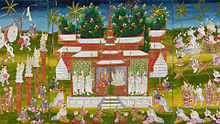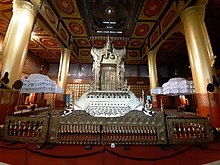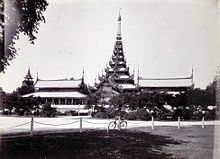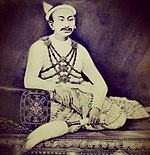Coronation of Mindon Min
 A contemporaneous painting of the coronation depicts the king and queen seated in the pavilion, surrounded by a retinue of Brahmins. | |
| Native name | မင်းတုန်းမင်း ရာဇာဘိသေက မုဒ္ဓါဘိသိက် ခံယူတော်မူပုံ |
|---|---|
| English name | Rājābhiseka Muddhābhisik (consecration) ceremony of Mindon Min |
| Date | 14 May 1857 |
| Venue | Mandalay Palace |
| Location | Mandalay,Burma |
| Participants | |
Thecoronation(Rajabhiseka) ofMindon MinandSetkya Dewiaskingandqueenof theKonbaung Kingdomtook place atMandalay Palaceon 14 May 1857.[1]
During the reign of the king's half brotherPagan Min,theSecond Anglo-Burmese Warin 1852 ended with the annexation ofLower Burmaby theBritish Empire.[2]Mindon Min and his younger brotherKanaung Minoverthrew Pagan Min,[3]and Mindon Min ascended the throne on 18 February 1853.[4]
Similar to other southeast Asian traditions, the coronation ceremony was a mix ofHinduandBuddhistcultures in whichPunna(Brahmins)[5]played significant roles, as Hindu texts provide guidelines for such social rituals and political ceremonies, while Buddhist texts do not.[6][note 1]
Following ancient customs similar to the coronations of the kings before him,[7]during the service, Mindon Min bathed, took an oath, and was anointed with holy water, invested with regalia, and crowned King of Burma. The oath included instructions on what to do or not to do for the benefit of his people and warned him that if he failed to oblige, he might suffer certain punishments.[8]
The coronation was private and attended by royal members and staff only, andKonbaung Set Yazawinshows no evidence survived to indicate attendance by foreign diplomats.[9]
Preparation[edit]
Choosing regnal titles[edit]
A committee was formed to chooseregnal titlesfor the King and his wife. It was chaired by thePrince of Mekkhayaand consisted of 14 ministers, includingKhanpat MingyiandMaigaing Myoza;fivePunna;and eightaccomplished and distinguished Rājagurusayadaws(seniormonks):Gwegyo Sayadaw,Seebanni Sayadaw,Mekkhaya Sayadaw,Thitseint Sayadaw,Hladwe Sayadaw,Bhamo Sayadaw,Wicittayama Sayadaw, and Bagan Sayadaw.[10]The committee met at the three-tiered Zetawun Hall and announced on the following day that, in accordance with thePāliandVedic Sanskritgrammar and prosody, the regnal titles of the King and the Chief Queen would beSīripavara Vijayānanta Yasapaṇḍita Tribhavanā Dityādhipati Mahādhammarājādhirājā(Burmese:သီရိပဝရ ဝိဇယာနန္တ ယသပဏ္ဍိတ တြိဘဝနာ ဒိတျာဓိပတိ မဟာဓမ္မရာဇာဓိရာဇာ,lit. 'Prosperous and Most Excellent Great Just King of Kings, Infinitely Victorious, Famous and Wise')[11]andSīripavara Atulatiloka Mahārājindādhipati Ratanādevī(Burmese:သီရိပဝရ အတုလတိလောက မဟာရာဇိန္ဒာဓိပတိ ရတနာဒေဝီ) respectively.[10]Aminister for decorations,Minhla Yaza Kyawhtin, was commissioned to inscribe the titles on the goldenpalm-leaf manuscripts,which were decorated withnawarat(nine esteemed gems) wound by ninerubystripes, at an auspicious moment in the same month.[12]
Making coronation costumes[edit]
Managed by the royaltreasurers,23 dressmakers and embroiders wearingnawaratrings made the diamond-decorated silvermagaik(Imperial crown), flame-likeepaulettesfor theduyin,left-and-rightsulya(shawls), three-layershebon(aprons) andbwebyu(robes).[12]Theduyin,sulyaandshebon,with silverjingle bellsdecorating the lining, were embroidered with silver silk in the shape of a star, ajackfruittubercleand agourdtendril.[13]When the outfits were completed, they were put onto peacock frames, and BuddhistParittaswere chanted by eight monks.[13]
Constructing mandats[edit]

A specially designated plot of land due east of the palace was harrowed by bankers' sons wearing yellow clothes, rich men's sons dressed in red, and farmland-lords' sons wearing green clothes with gold, silver and tin ploughs attached to bulls (not oxen as usual).[1]This was followed by splashing milk, sprinklingcow dungpowder and scatteringbarley,sesame,cotton,maize,rice,peasandbeansthoroughly over the ground. The plot was fenced with a type of latticework calledDaunggyan.[14]Punnaperformedfire rituals[15]and started chantingmantrasfromRajamattan[13][note 2]when carts carrying statues ofChandi,ParameshwaraandVishnuarrived.[14]Then, representative monks of allnikayas and 12 court Brahmins recitedparittas, such asMaṅgala SuttaandRatana Sutta,andKammavaca[note 3]asPunnadevoted tonatspirits blewKhayuthin(conch shells) and chanted the mantraKaranasrishanta.[14]
After wood, bamboo,rattanand building materials were washed withlustral water,eight astrologers and four family members waited while the site was staked by sailors,paritta-chantingPunnaand landowners; these were dressed in brown, red and green and held gold, silver and tin stakes respectively. The staking was scheduled to occur under the influence of auspicious constellations and signaled by firing seven flintlocks seven times.[13]Theathes(civilians) built three ceremonialmandats(pavilions):[14]
- ASihasanamandat(withLion Throne), draped in white and attended by theparitta-recitingPunna.
- AGajasanamandat(with Elephant Throne), decorated in red with sailors in attendance.
- AMorasanamandat(withPeacock Throne), decked in brown and presented byathes.
Collecting anointing water[edit]
A group involving eightsupayas with gold pots, eight daughters ofpuroheits(courtPunna) with silver pots, eight daughters of ministers with earthen pots, eight daughters of bankers with brass pots and eight daughters of rich men with iron pots went to theIrrawaddy Rivertogether with eightabhiseka-performingPunnaled by theThathanabaing sayadaw.[14]The water had to be taken from midstream; all embarked on separate boats according to their grades.[14]
When they arrived at the riverside, participants dressed up asGanga(the guardian spirit of the river) said three times, "Why do you all come?" "According to tradition, as in the case of his forbear, the King intends to hold anabhisekaceremony. Thus have we come to draw water, "thepuroheits replied.[16]Ganga asked, "Will he work for the religion (Sasana), the Samgha and the people and act according to the law? ";" The King wishes so to act and thus wants the water, "they answered.[16]
Ganga said, "Very well! Very well! May the King live a hundred years and look after the interests of the religion, the Samgha and the people. May his children, grandchildren and great-grandchildren prosper," and allowed them to get water.[16]
The holy water obtained by thesupayas and daughters ofpuroheits was placed at theSihasanamandat,that of the ministers' daughters at theGajasanamandatand that of the bankers' and rich men's daughters at theMorasanamandat.[16]
Procession to the mandat[edit]
The middle part of the route from the palace to themandats was shaded with gold and silver cloth so that no sunlight could fall on the path.[17]
In the vanguard of the procession were twelve regiments with members of legislatures to the left and right, the front ranks of the palace guard commanders and the left ranks of the palace guard commanders; in the rear were twelve regiments with members of legislatures to the left and right, the back ranks of the palace guard commanders and the right ranks of the palace guard commanders, all formally arranged.[18]These were followed by 100abhisekaPunnaheaded by twoChakravartison each side; theThathanabaing sayadaw;Brahma Chandra, the Chief Puroheit, carrying aDakshinavarti Shankhin a golden basket with joined hands; 100Huyas(astrologer Brahmins); 100Punnawho sacrificed tonatspirits; 100 harpistPunna;100Punnarecitingparittas; 100Punnaoffering flowers; eight princesses; eightPunna's daughters; eight bankers' daughters; and eight rich men's daughters. All 500Punnablew onKhayuthins.[18]The King and Chief Queen, each proceeded and followed by a princess wearingGhanamatthakaclothes, processed in a golden palanquin to theakhazauntmandatto await the auspicious moment for beginning the ceremony.[18]
Event[edit]
Preceding the King and Chief Queen into themandatwas theTipitakacarried by the Thathanabaingsayadaw,Vinayadhara(ဝိနည်းဓိုရ်;custodian of theVinaya)[note 4]and 12puroheit.After a prescribed interval it was removed to the palace where 108 monks were chantingparittas.[18]Then the palace was cleaned by thePyisogyiminister (registrar general;ပြည်စိုးကြီးအမတ်).[18]
Bathing of the King[edit]
The King and Chief Queen proceeded to theMorasanamandatand put on the dresses offered by theNanya Mibayas(Senior Queens); they continued to theGajasanamandat,where the King was anointed byMyadaung SupayawithThagyayezinholy water from a golden bowl and by three ministers with 20 golden pots.[19]The King's hairline was washed byYamethin SupayaandGrahashanti-recitingBhidrawith the Dakshinavarti Shankh.[19]Afterwards, offerings were donated to seven Buddha images.[note 5][19]
Crowning, anointing and oath-taking[edit]


Around 7 am, the diamond-decorated silvermagaik,flame-like epaulettes attached toduyin,left-and-rightsulya,three-layershebonandbwebyu,after being praised by eightPunna,were offered to the King byMai Noung Supaya,Salin SupayaandYamethin Supayain order.[19]
The King and Chief Queen made a variety of donations while thePyaut Gyi Hmue(captain of the footguards) read the ceremonialyadu(ode); theNavagraha(heavenly deities) were given offerings byPunna.[19]Later, the King and Chief Queen went clockwise round theSihasanamandat,stopping on the eastern side.[19]In front of theGreat Audience Hall,the King was invested with theThanlyet(sceptre) andTaungmway(staff).[19]
When the princesses opened theU-gin[note 6]holding theThanlyetandTaungmway,the King recited:[19]
Buddhañca Dhammañca Saṃghañca saranaṃ gato, upāsakattaṃ desesi. Sakyaputtassa sāsane, sadāguṇa mupehīti.
The King and Chief Queen sat in state on the gold-coveredfigwoodin theSihasanamandat.[20]
EightPunnahanded the King the five components of the coronation regalia: theHti byu(white umbrella),Magaik,Thanlyet,Che nin(sandals) andThamee yet(fly-whiskmade of yak tail).[19]Yaw Atwinwunread the regnal title of the King from the golden palm-leaf manuscript, which, together with its ruby-studded stand, was then offered to the King bythe Prince of Mekkhaya.The regnal title of the Chief Queen was read by Kanni Atwinwun and offered to her bythe Prince of Nyaungyan.[19]
At 8:30 am, eightsupayas dressed inGhanamattaka,holding Dakshinavarti Shankh filled with water from five rivers by Yamethin Supaya, poured water on the King's head[21]while saying:
Oh King! please act always as the good and righteous kings fromMahāsammataat the beginning of the world onwards. Oh King! do not be harsh to your vassals, bestow rewards on all deserving people, love compassionately everyone as though they are children of your bosom, guard the welfare of everyone, treasure their lives as though your own. May you be free of the obstructions of greed and anger, and give light to the darkness of stupidity. Oh King! your actions must be only those that bring you credit, so must your words, your thoughts and zeal.
Holding Dakshinavarti Shankh filled by Brahma Chandra the Chief Puroheit, eightPunnaof pure blood also anointed the King,[21]saying:
Please make the Sasana and its attributes shine forth. Oh King! love all beings as your own children, their weal and their lives must be as your own. Oh King! do not be harsh to your vassals. Be just, attend to the sayings of the wise, and look after your kith and kin. This you must always do.
Then, holding Dakshinavarti Shankh filled by Maha Thiri Dhanaraja, eight bankers and rich men anointed the King[21]with these words:
Oh King! look after everyone as yourself. Guard their welfare as your own. Do not be harsh to your vassals. Be just in your taxation. Eschew the unjust and the foolish. Consult the wise men and take their advice.
Oh King! May you receive the tax according to theThathamedalaw. May the kings of many countries bow their heads before you, may there be no thieves or robbers. Oh King! if you break your oath, may the world be ruined by earthquakes, hell-fires, rebels and witches.
End of the event[edit]
Mindon Min then proclaimed, "I am foremost in all the world! I am most excellent in all the world! I am peerless in all the world!",[24]gave a speech in which he asked to be "victorious over his dangerous enemies" and to "attain thewhite elephantand the treasures [to become, in other words,Chakravartis] ",[25]and made an invocation by pouring water from a golden ewer.[24]The ceremony ended with the king taking refuge in theThree Jewels.[24]
Thenbhisikpan(flowers) were offered to eight abhiseka-performingPunnaby the minister of royal treasurers, Minhla Sithu.[26]Princesses who had been given the honor of making speeches beat a silver gong andcymbal.[27]Afterward, meals were offered to aNanthintBuddha image[note 8]before being given away to a person and a cat.[27]About one hour later, the King and Chief Queen had their lunch, then left the Great Audience Hall.[27]
Commemorations[edit]

As part of the coronation, the squareyuzana(12.72 squaremi) around the capital was designated asanctuary;all prisoners were released; and firewood, flowers and fruits were donated to all monks andPunna.[26]The edicts were received byThandawsintand were transmitted toNagandaw(who presented matters to the King for his decision and relayed the decision to those concerned).[26]
Seven days later, around 11:30 am, the King (dressed as Brahma) and Chief Queen (dressed as a Queen of thedevaloka) gave royal audiences to ministers and generals.[27]After that, the king and members of the royal family made an inaugural procession, circlingthe city moaton a gilt state barge, amid festive music and spectators.[28]
Notes[edit]
- ^Some Brahmins formed an influential group in Burmese Buddhist kingdoms in 18th- and 19th-century. The court Brahmins were locally calledPunna.During theKonbaung dynasty,Buddhist kings relied on their court Brahmins to consecrate them to kingship in elaborate ceremonies, and to help resolve political questions. This role of Hindu Brahmins in a Buddhist kingdom, states Leider, may have been because Hindu texts provide guidelines for such social rituals and political ceremonies, while Buddhist texts do not.
- ^A standard reference for ceremonies at the royal court compiled duringBodawpaya's reign
- ^A selected collection of sacred Pali texts written in a square script
- ^Asayadawlearned in theVinayaswho delivers judgement on disputes involving the ecclesiastic code.
- ^The seven images represent the seven Buddhas:Gautama Buddhaand the six preceding Samma Sambuddhas.
- ^The uppermost part of the back of the throne.
- ^Translation: "Having taken refuge in the Buddha, the Dhamma and the Sangha, he pointed out the fact of his being a lay-disciple. Always trust in the virtue of the biddings of theSakyaputta.i.e. the Buddha. "
- ^A Buddha image sculpted to reference a particular planet corresponding to one's name.
References[edit]
Citations[edit]
- ^abYi Yi 1982,p. 136.
- ^Myint-U 2001,p. 106.
- ^Myint-U 2001,pp. 105–106.
- ^Beck, Sanderson."Burma, Malaya and Siam 1800–1950".Retrieved2007-04-22.
- ^Leider 2005,p. 160.
- ^Leider 2005,p. 174.
- ^Hpo Hlaing 2004,p. 59.
- ^Leider 2005,p. 175.
- ^Maung Maung Tin 2004,pp. 273–274.
- ^abMaung Maung Tin 2004,p. 269.
- ^Yi Yi 1982,p. 101.
- ^abMaung Maung Tin 2004,p. 270.
- ^abcdMaung Maung Tin 2004,p. 271.
- ^abcdefYi Yi 1982,p. 137.
- ^Raymond 1987,pp. 217–218.
- ^abcdYi Yi 1982,p. 138.
- ^Maung Maung Tin 2004,p. 273.
- ^abcdeMaung Maung Tin 2004,p. 274.
- ^abcdefghijMaung Maung Tin 2004,p. 275.
- ^abYi Yi 1982,p. 140.
- ^abcMaung Maung Tin 2004,p. 276.
- ^abYi Yi 1982,p. 141.
- ^Collins & Huxley 1996,pp. 634–635.
- ^abcHarvey 1925,p. 325.
- ^Collins & Huxley 1996,p. 635.
- ^abcMaung Maung Tin 2004,p. 277.
- ^abcdMaung Maung Tin 2004,p. 278.
- ^Scott 1882,p. 450.
Sources[edit]
- Collins, Steven; Huxley, Andrew (1996)."The Post-Canonical Adventures of Mahāsammata".Journal of Indian Philosophy.24(6): 623–648.doi:10.1007/BF00165541.ISSN0022-1791.JSTOR23447964.S2CID170908946.
- Harvey, G. E (1925).History of Burma: From the Earliest Times to 10 March 1824.London: Frank Cass & Co. Ltd.
- Hpo Hlaing(2004).Rajadhammasangaha(PDF).L.E. Bagshawe (translator).
- Leider, Jacques P. (2005). "Specialists for Ritual, Magic, and Devotion: The Court Brahmins (Punna) of the Konbaung Kings (1752–1885)".Journal of Burma Studies.10(1): 159–202.doi:10.1353/jbs.2005.0004.S2CID162305789.
- Maung Maung Tin, U (October 2004).Konbaung Set Yazawin (Chronicle of Konbaung Dynasty)(in Burmese). Vol. 3 (4th ed.). Yangon: Department of Universities History Research, University of Yangon.
- Myint-U, Thant (26 March 2001).The Making of Modern Burma(1 ed.). Cambridge University Press.ISBN978-0-521-78021-6.
- Raymond, Catherine (1987).Etude de cultes populaires en Birmanie dans l'art et les textes birmans.Paris: Université de Paris iii-Sorbonne nouvelle.
- Scott, James George(1882).The Burman, His Life and Notions.London: Macmillan.
- Yi Yi, Dr (1982).Life at the Burmese Court under the Konbaung Kings.Yangon: Department of Universities History Research, University of Yangon. pp. 100–147.



